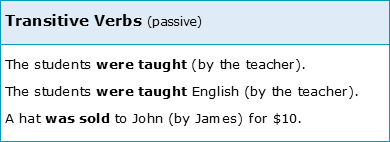How are intransitive and transitive verbs different?

This is the second of three chapters about Verb Transitivity. To complete this reader, read each chapter carefully and then unlock and complete our materials to check your understanding.
– Discuss the structures and rules of intransitive verbs
– Discuss the structures and rules of the three types of transitive verb: monotransitive, ditransitive and tritransitive
– Use examples taken from academic contexts to demonstrate these verb structures in use
Before you begin reading...
-
video and audio texts
-
knowledge checks and quizzes
-
skills practices, tasks and assignments
Chapter 2

In Chapter 1 of this short reader on verb transitivity, we explored what verb arguments are and discussed the differences between the transitivity and valency of a verb. We determined that a predicate, or verb phrase, almost always requires one subject argument to be grammatical but that it may also have three additional object arguments depending on the particular verb and its subject.
We explored how the term ‘transitivity’ is used to differentiate predicates that take direct objects from those that don’t, and outlined how ‘valency’ determines the specific number of object arguments within a clause. In this next chapter, the structures and rules of transitive and intransitive verbs are discussed more specifically, with examples taken from academic contexts.
What are intransitive verbs?
Intransitive verbs such as ‘laugh’ or ‘smile’ are verbs which can take a subject argument but cannot grammatically include any object argument:


In intransitive constructions such as ‘the man laughed’ and ‘the woman smiled’, the clause will at a minimum require a subject and a predicate (verb phrase) to be grammatical – although as can be seen in the following examples, these constructions may also take optional adjuncts such as ‘very hard’ or ‘at the man’. Due to their lack of an object however, intransitive verbs cannot be made passive:


Some academic examples of intransitive verbs are provided for you below:
“The bacteria quickly adapted (to its new environment).”
“The results did indeed develop (as predicted).”
“Something unusual emerged (from the results).”
“It increased (at a phenomenal rate).”
“All researchers should participate.”
What are transitive verbs?
Conversely, transitive verbs such as ‘teach’, ‘give’ and ‘pay’ are able to take object arguments and subject arguments and as such can be made passive:


These verbs come in three types depending on how many object arguments they grammatically require. A monotransitive verb, for example, requires only one direct-object argument in addition to its subject argument, meaning that it has two arguments in total. A ditransitive verb, however, may take a direct object argument and an indirect or oblique object argument, totalling three. Finally, with four arguments, a tritransitive verb such as ‘sell’ is able to include all three types of object within its argument structure, such as is exemplified in the table below:


In truth, there are few ditransitive and even fewer tritransitive verbs in the English language, with monotransitives being by far the most common type of transitivity.
Some academic examples of transitive verbs are provided for you below:
“The board allocated $3,000 to the study.”
“The results benefited group A more than group B.”
“The scientists developed the vaccine over the course of three years.”
“I identified the problem with the methodology and rescheduled the test.”
“The experiment involved 2,500 participants from fifty-six countries around the world.”
Can some verbs be both intransitive/transitive?
What you may have noticed in this short reader on verb transitivity is that some verbs such as ‘melt’ or ‘teach’ may be grammatical when either intransitive, monotransitive or ditransitive. Remembering back to the examples of Chapter 1 that used the verb ‘melt’, the transitivity of a verb may in fact depend upon the type of subject that’s been included. As is demonstrated below, when the subject is ‘ice cream’ then the verb ‘melt’ is intransitive, whereas when the subject is ‘the sun’ a monotransitive ‘melt’ is required to be grammatical. This is because it’s semantically (almost) impossible for an ice cream to melt something or for the sun to melt:


Now that we’ve explored verb transitivity in some detail, the final chapter in this reade introduces the 150 most common academic verbs and separates them into their valency types.
Downloadables
Once you’ve completed all three chapters about verb transitivity, you might also wish to download our beginner, intermediate and advanced worksheets to test your progress or print for your students. These professional PDF worksheets can be easily accessed for only a few Academic Marks.
Collect Academic Marks
-
100 Marks for joining
-
25 Marks for daily e-learning
-
100-200 for feedback/testimonials
-
100-500 for referring your colleages/friends